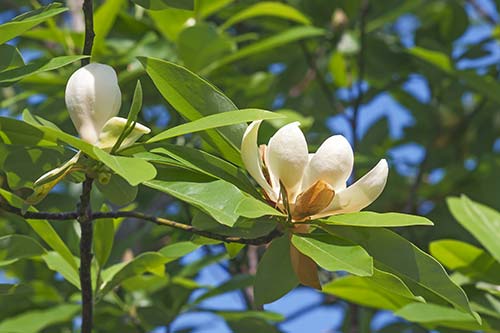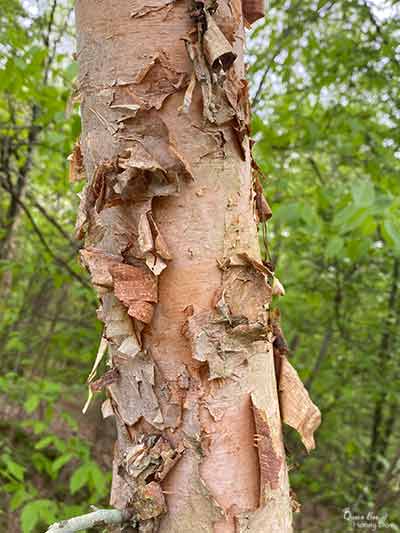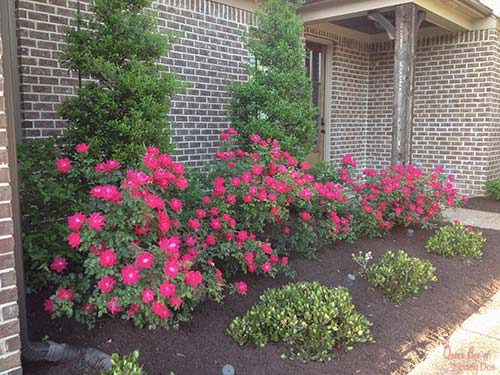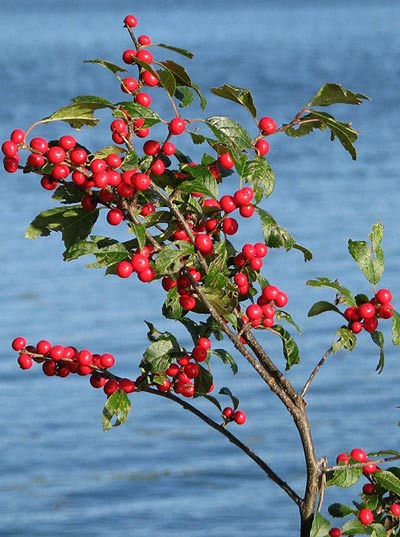If you live in a place that has clay soil and you are struggling to keep your plants alive, all is not lost. You can have a lush and beautiful landscape. You just have to know how to grow plants in clay soil and which plants thrive in this type of dirt.
The good news is that clay soil is packed with nutrients. The bad news is that it can be hard for plants to tap into those nutrients.
Clay soil tends to pack together tightly cutting off all oxygen and suffocating the plants. When it is dry, it is nearly impossible to penetrate with water.
When it gets wet it turns into a sticky mess. If you dig a hole for a plant, that hole turns into a basin that drowns the roots. So what to do.
Methods to Deal with Clay Soil
You could make attempts to condition the soil. Many soil amendments will make hard-packed clay into workable soil. However, this is usually a process that takes time and patience.
You could also practice the proper technique for planting clay soil – a technique that requires the root ball to be raised 3-4 inches above ground level. This allows the roots to receive oxygen and avoids the problem of creating a basin.
It also ensures that the root flare is above elevation (a common mistake that causes trees to suffer), and leaves plenty of room for settling. For heavy clay, a combination of this technique and soil amendments work best.
You could also use plants that thrive in clay soil. In doing so, you will better ensure success. Also, these types of plants will help to break up that hard soil with their roots and begin the process of naturally amending the soil. However, they will still need to be planted with the correct method for clay soils.
What Type of Root Systems Are Best for Clay Soil
When it comes to clay soil, the best plants have particular types of root systems. Plants that have deep and/or strong taproots can tunnel right through some of the heaviest clay soils with no problem. These are great for breaking up hard soils and reaching deep to bring nutrients to the surface but are generally not planted for their beauty.
Plants that have a rhizome root system tend to do well in clay. These types of plants grow in clumps with roots that spread out to the side rather than downward. Most are shallow with the tops of the rhizome exposed. Because of this structure, the plants do not suffer from oxygen depletion the way other root systems can.
There are many plants with very dense fibrous roots that do well in clay. These are typically clumping as well. Grasses and sedges are good examples of this type of system.
Plants that do well in wet or boggy areas can often tolerate clay soils. You may need to make a few concessions mentioned before, but since these type of root systems enjoy frequent water logged settings, they can survive the slower drainage that comes with clay soil.
Ornamental Trees to Consider
Many types of trees do well in clay soil. Unfortunately, most of those trees are more suitable for large parks or lawns and won’t work for the average patio or landscape. However, there are some good selections to be found for ornamental trees that will thrive in clay soil.
Because clay soil is known for its bathtub/basin effect, many of the trees that will thrive under these conditions are trees that prefer boggy areas. This is true for the Sweetbay Magnolia.
Known for its smaller but very fragrant version of the magnolia blooms, Sweetbay makes a beautiful specimen or patio tree. It can take full sun in most locations and will even thrive in dappled shade in warmer climates.
Sweetbay will grow about 12 – 24 inches per year and will reach a height of 15 – 20 feet. It can thrive in zones 5 – 9; However, in zones 5 and 6 it will perform like a deciduous tree. While in zones 7 through 9, this tree will be evergreen.
Saucer magnolias are one of the first bloomers each spring. They have large deep pink to purplish blooms that are quite stunning. It prefers full sun and may require early protection in colder climates.
The saucer magnolia is also a medium grower, putting on an extra 12- 24 inches each year. It grows in a rounded form and will reach approximately 25 feet. Plant this tree in zones 4 – 9.
This is a smaller version of the traditional southern magnolia. It will only reach between 20-25 feet which makes it an excellent choice for smaller properties, patios, and specimen trees. It has a slow growth that prefers full sun to part sun.
Like the rest of these trees, Little Gem can withstand occasional light flooding and also short periods of drought once it is established. Plant this tree in zones 6-10.
This tree is desired for its beautiful cinnamon-colored bark which peels away from the tree in thin paper-like layers. It creates beautiful fall color and will add wonderful color for a winter landscape.
The paperbark maple is a slow grower that will reach approximately 25 feet and prefers full sun to part shade. It is hardy in zones 4 – 8.
When it comes to plants and trees with interesting bark, the river birch can’t be beaten. It can survive in many less than ideal locations and is a wonderful specimen for planting in areas that suffer from occasional flooding. It is a fast grower that can reach over 40 feet in height.
The bark on saplings is a smooth silvery texture that begins to peel in cinnamon layers as the tree matures. This tree needs at least four hours of unfiltered light but can thrive in full sun or shady areas. You can plant this tree in zone 4 – 9.
Desired for their fan-shaped leaves, these trees start with a lovely shade of green that turns into a brilliant shade of yellow during the fall. It is a slow grower, gaining only 6 – 12 inches per year, but will reach between 25 – 50 feet depending on the variety.
In addition to tolerating clay soils, the ginkgo can also tolerate short droughts, compacted soils, and pollution – this has made it a great choice for commercial landscaping. All varieties of this tree need full sun and are hardy in zones 5 – 9.
Best Perennials for Clay Soil
Don’t overlook those perennials. They are great low-maintenance space fillers that serve a purpose other than adding color and visual interest. These plants will help to aerate the soil and help to control erosion. They also add back nutrients to the soil and provide food for the desirable garden critters. All these things will benefit the soil and the other surrounding plants.
Hostas grow dense mounds of large leaves that come in a large selection of green and creams. They perform very well in clay soil and can be divided in early spring or late fall. However, they are a favorite plant amongst deer and you may need to deal with slugs, but they are well worth the effort.
They do not tolerate sunny areas well. So, plant these in shady spots or in dappled sunlight only. These are hardy in zones 3 – 8.
Daylillies are a popular choice when it comes to clumping plants. Their large blooms attract butterflies and hummingbirds.
Deer love to eat these, though. So, if you have deer that frequent your landscaping, place these in a location that will provide protection. Otherwise, they will be a much-appreciated buffet.
They bloom late summer to early fall and prefer full sun – part shade. They are hardy in zones 3 – 9.
This sun-loving perennial is from the daisy family. It is also a clump-forming plant that can be divided about every four years and is a big attractor for both butterflies and bees.
It blooms from mid-summer through early fall and needs full sun. Plant these in zones 3-9.
Sedum, AKA Stonecrop, comes in many varieties. Of these autumn Joy is a great choice for dry clay soil. In fact, these are very drought tolerant. They also attract butterflies and other pollinating insects.
They bloom large landing pads of gorgeous tight pink flowers from late summer through early fall and go on to provide beautiful winter interest. They prefer full sun and are hardy in zones 3 – 9.
Also popular for its ability to attract hummingbirds, butterflies, and pollinating bees is Bee Balm. It is loved for its beautiful flowers that come in shades of pinks, purples, and even white.
Blooms appear from early-mid summer. They don’t like to be crowded, so make sure they have adequate space for air to circulate. Plant these in moist sunny locations and they will do well. They are hardy in zones 3 – 9.
Bearded irises require well-draining soil or they suffer from root rot. This may seem to be a contradiction for most clay soils. However, these beauties prefer their rhizomes to barely be covered with soil.
In fact, many gardeners prefer the rhizomes to be only half covered. This means that even in clay soil, it is easy to plant these so that they are not standing in water. In heavy soil, adding amendments to the first few inches is usually enough to allow irises to get established.
They are a favorite with butterflies and hummingbirds. For best results plant them in full sun unless you live in one of the warmer southern areas where these can tolerate a bit of afternoon shade. They bloom from late spring-early summer and can be grown in zones 3-9.
These too will attract butterflies and bees. What’s more, they will bring goldfinches to your lawn. They are a great source of food for birds during the winter and are one of the few plants that are deer resistant.
They produce vibrant blooms in yellow with large, velvet, brown, centers from mid-summer all through early fall. They like moist soil with full to part sun and will grow in zones 3-9.
Smooth hydrangea (aka wild hydrangea) such as Annabelle can be found on wooded slopes and near creeks and streams. They will grow in clay soil and when given similar conditions to their preferred natural locations (i.e moist and shady) they will thrive.
Avoid giving them too much direct afternoon sun and don’t let them dry out and they will be their happiest. These grow between three-five feet and on occasion have been known to grow a bit taller.
They also grow on new wood which means you can gut back the plants during the winter without worry. Smooth hydrangeas bloom from early to mid-summer. Plant in part shade in zones 3-9.
Shrubs for Clay Soil
Shrubs are typically what we choose to add variations in height for our landscaping. They can go places where trees can’t, and they are often the go-to plant when choosing foundation plants.
Knockout roses are by far the easiest roses you will ever grow. They are also one of the most proliferate bloomers of any shrub. They bloom from spring all the way through fall. I have even had mine put out blooms during the winter when the weather has been mild.
You can plant these in rows, groupings, or as individual accents. Most varieties will reach up to four feet high and several feet wide within just a few years. In fact, without proper pruning, these shrubs can achieve several feet more than the labels indicate.
These need full sun but can tolerate a small amount of shade. When pruned to be kept compact, they pair nicely with panicle hydrangeas. Plant these in zones 5 – 10.
Dogwood shrubs, not to be confused with the more finicky dogwood tree, are spectacular shrubs that provide even more spectacular winter color. They can handle almost anything thrown at them – clay soil, sun or shade, wet or dry, deer or rabbit. This one has it all covered.
A few of the most popular dogwoods are arctic fire and arctic sun. However, there are many other varieties that range in color, size, and hardiness zones. You can find dogwood shrubs for zones 2 – 9. However, many varieties are restricted to zones 4 – 7. So, check before you buy.
Chokeberries are covered in tiny springtime flowers and have vibrant fall colors. They thrive in all types of problem soils including boggy soil and clay.
These are favorites for woodland gardens and look lovely next to a pond. Plant these in full sun to part shade. The red varieties are hardy in zones 4 – 9, and the black variety in zones 3 – 8.
This Holly is another shrub that is popular for its amazing winter color. It can handle heavy clay, wet conditions, and shade. But, to produce berries, you must have at least one male pollinator for every four to five females.
Most landscaping/gardening centers will have a recommended male to pair with your choice. However, they may not be required if you live in an area that is already populated with winterberries.
These shrubs do well in full sun to part shade and are hardy in zones 3 – 9.
Ornamental Grasses and Ground Covers
Grasses should not be overlooked when planning your clay soil landscape. These are great at breaking up hard soil. They work well around patios, ponds, walkways, and even as focal points. Plus, many varieties add visual interest during the winter.
This elegant beauty can grow in some of the worst soil conditions. Not only is it tolerant of clay soil, but it is also tolerant of less than ideal drainage. It grows in clump form and can be divided about every four to five years.
This maiden grass should not be cut back until early spring. But why would you anyway? The leaf blades create some spectacular winter interest.
It prefers full sun but will tolerate part shade in warmer zones. Be sure to give these plenty of room to expand. Overcrowding with each other will make it difficult to do divisions later on. Plant them in zones 5-9
There are two types of Liriope – Muscari and Spicata. You want to make sure that you are aware of which type you are planting.
Spicata spreads very quickly by runners and is best suited for ground cover. It does not make a good border plant as it can and will take over the entire bed.
Muscari grows in clumps that behave similarly to other clumping grass forms. It makes good borders plants and does well in areas where you want to maintain a controlled boundary.
All varieties produce small spikes with blooms in either white, pinks, or purples. However, they are typically chosen for their evergreen beauty. Leaf colors come in shades of green, blue-green, and variegated forms.
You can find selections in both shade and full sun tolerant. They are hardy in zones 6 – 10. A few varieties can survive the warmer areas of zone 5.
Final Comments
These are just a few great performers for those of use cursed (blessed) with a yard full of clay soil. From this selection, a large lush landscape can be had. Try some!
























Maribel says
Thank you so much for the information. It was very helpful because, l didn’t know anything about clay soil and it’s exactly the soil that my patio have now l understand why almost all the plants that I plantings die. Thank you.
Robyn Mills says
I see all the plants that thrive in my yard on this list …. Some I don’t have but will use this guide for new things!